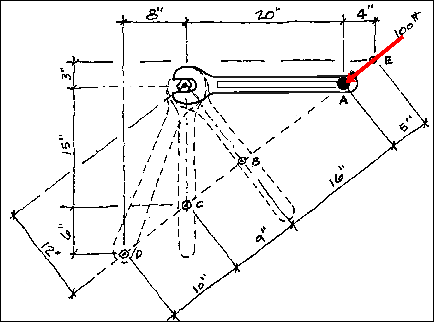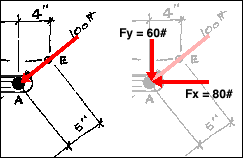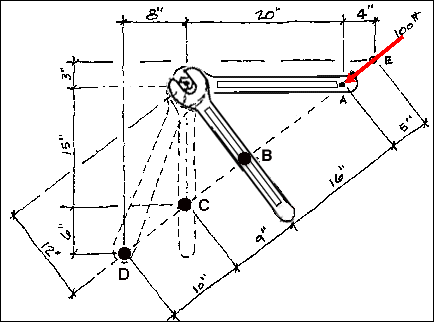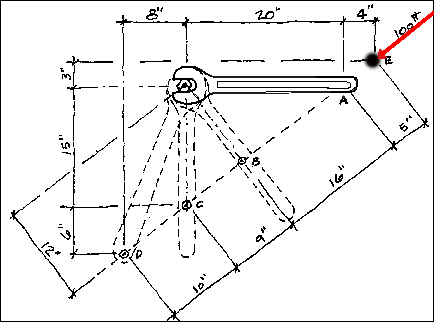

The Principle of Moments

First consider the 100 pound force

Since the line of action of the force is not perpendicular to the wrench
at A, the force is broken down into its orthagonal components by inspection.
The line of action of the the 100 pound force can be inspected to determine
if there are any convenient geometries to aid in the decomposition of the
100 pound force. The 4 inch horizontal and the 5 inch diagonal measurement
near point A should be recognized as belonging to a 3-4-5 triangle. Therefore,
Fx = -4/5(100 pounds) or -80 pounds and Fy
= -3/5(100 pounds) or -60 pounds.
Consider Point A
The line of action of Fx at A passes through the handle of the
wrench to the bolt (which is also the center of moments). This means that
the magnitude of the moment arm is zero and therefore the moment due to
FAx is zero. FAy at A has a moment
arm of twenty inches and will tend to cause a positive moment.
FAy d = (60 pounds)(20in) = 1200 pound-inches or 100 pound-feet
The total moment caused by the 100 pound force F at point A is 1200 pound-inches.
 Consider
Point B
Consider
Point B
At this point the 100 pound force is perpendicular to the wrench. Thus,
the total moment due to the force can easily be found without breaking it
into components.
FB d = (100 pounds)(12in) = 1200 pound-inches
The total moment caused by the 100 pound force F at point B is again 1200
pound-inches.
Consider Point C
The force must once again be decomposed into components. This time the vertical
component passes through the center of moments. The horizontal component
FCx causes the entire moment.
FCx d = (80 pounds)(15inches) = 1200 pound-inches
Consider Point D.
The force must once again be decomposed into components. Both components
will contribute to the total moment.
FDx d = (80 pounds)(21inches) = 1680
pound-inches
FDy d = (60 pounds)(8in) = -480 pound-inches
Note that the y component in this case would create a counterclockwise
or negative rotation. The total moment at D due to the 100 pound force is
determined by adding the two component moments. Not surprisingly, this yields
1200 pound-inches.

Consider Point E
Varignon's Theorem applies even though point E is removed from the physical
object. Following the same procedure as at point D;
FEx d = (80 pounds)(3in) = -240 pound-inches
FEy d = (60 pounds)(24in) = 1440 pound-inches
However, this time Fx tends to cause a negative moment. Once again the total moment is 1200 pound-inches.
Summary for the example At each point, A, B, C, D and E the total moment around the bolt caused by the 100 pound force equalled 1200 pound-inches. In fact, the total moment would equal 1200 pound-inches at ANY point along the line of action of the force. This is Varignon's Theorem.
hmmmm.......
TBA